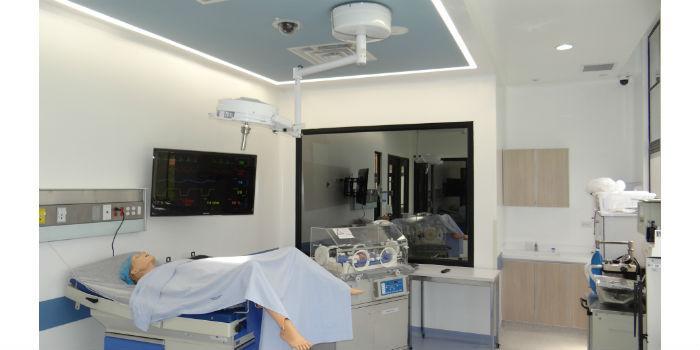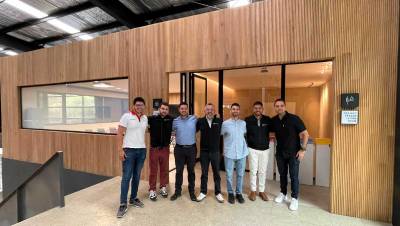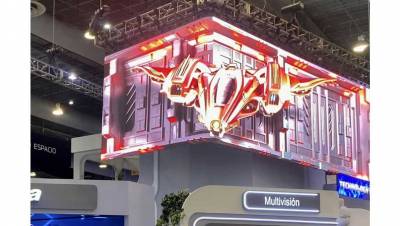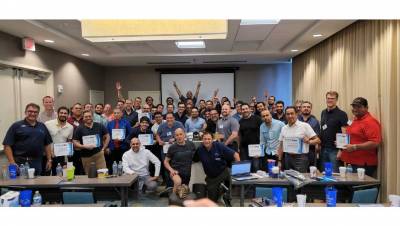 Clinical simulation is an education strategy used to develop skills and abilities in students. AV technology is a fundamental part of the process.
Clinical simulation is an education strategy used to develop skills and abilities in students. AV technology is a fundamental part of the process.
Richard Santa
Responding to the need to take the learning experience of students in the health sector to a higher level, in which they could develop skills and abilities by applying theoretical knowledge, the University of La Sabana, located on the outskirts of Bogotá, Colombia, created a simulated hospital.
Angélica Villarraga, head of the Simulated Hospital and Specialized Classrooms of the Faculty of Medicine of the University of La Sabana, told AVI LATINOAMÉRICA details of this project that has been operating for about two years and through which more than 2,000 students have passed.
He explained that what was done at the University of La Sabana in Bogotá was to recreate clinical spaces as close to reality as possible for students to demonstrate their knowledge. "The simulated hospital is based on the concept of multifunctionality, that is, it does not have a space for a single thing, depending on the requirements of the teacher, we are doing the adaptation."
This simulated hospital comprises: a central nursing, five multifunctional scenarios for any situation or medical requirement, with gesell cameras and use of real medical devices; student observation rooms, two debriefing rooms and two multiple rooms, one for hospitalization and one for emergencies.
To develop this project, the University worked hand in hand with the Colombian AV integrator Cosmos Sistemas Integrados, CSI, who took advantage of their experience in audio and video together with other companies to return this pedagogical and teaching space.
Integrated AV technology
In the 382 square meters occupied by the simulated hospital within the main campus of the University, an important deployment of AV and IT technology was made, adapted to constructive standards and the particular demands that the University had.
Miguel Díaz, director of CSI's Engineering department, explained that the main challenge was more focused on the end user, the group of teachers. They had to create an easy and intuitive solution because those who operate the system are not technical personnel or with great knowledge of systems or technology and that would allow them to introduce a new role that they had to play in their daily work as a teacher, teaching with technology.
In this simulated hospital, five areas with control rooms, two additional areas for the observation of students, hospitalization, emergencies and two debreafing rooms were intervened. In total 11 zones with audio and video, all IP.
In the simulation rooms there are located 7 PTZ cameras and 9 fixed for the recording of reactions of the students in the face of some eventuality in the normal development of a class. All are full HD cameras at 60 frames per second. In addition, there are ceiling microphone and amplification systems for communication between the student and the teacher from the control room.
From the gesell cameras or control rooms, the teacher has the option to control the simulators, the cameras, the communication with the students and even direct the audio and video signal for the student observation rooms or the debreafing rooms. Each control room is thermally and acoustically isolated to achieve the highest concentration of teachers.
The students' rooms have a monitor and audio amplification that allows them to see and hear what is happening in the simulation room. In the debreafing rooms they can also hear and see what happens in any of the simulators by decision of the teacher.
There is a QSC system which centers the audio of all spaces and routes to all areas where amplification is needed according to the required profiles. If there are simultaneous teachers in the five simulation rooms, they can route without any affectation.
As the main brain of video processing there is an Apollo solution, under a collaborative software platform that allows any video signal to be routed to any space. This processing system is the one that receives the images from the simulators and cameras through a d100 - 1000 PoE network that is distributed within the simulator. At the video level this is the main element.
All sessions are recorded, for which a recorder is used is Exacqvision, which stores audio and video of everything that happens permanently inside the simulated hospital. That information is then taken by teachers for analysis and evaluation. The system has the capacity to store the information for up to one year.
Challenges and results
Miguel Díaz stressed that "in terms of technology there were challenges, integration of solutions, with major brands such as Shure, Biamp, Bosch, a very strong recording solution. It was a major challenge for everything to be in harmony and work very well, just a click away from what the teacher wanted."
He added that the rack room had a particular requirement. A few years ago, in a winter season, the University suffered a flood due to the overflow of the Bogotá River, with which the water rose more than a meter inside the campus. Therefore, despite the physical adaptations to avoid these floods, the rack room is located on a platform that exceeds two meters in height.
To reach the result that the University has today with the simulated hospital, they carried out a teamwork and multidisciplinary. The design work lasted about 6 months during the second half of 2017 and the work was done in a short period of 42 days, doing synchronous work from the gray work to optimize all the details.
With the technology implemented, said Angélica Villarraga, the hospital can simulate all the situations that attend to the individual life cycle, from gestation to the patient who is going to die, which are in hospital spaces of low, medium and high complexity, such as outpatient consultation, hospitalization, emergencies or special care units.
One of the main results of this technological implementation of the simulated hospital is that before the simulation classrooms were used only from the third academic week to the 16th, today the 24 weeks of the academic semester are used.
"In the simulated hospital they acquire skills that they hardly achieve in theoretical training. For example, with difficulty students will be allowed to have contact with an extreme baby. The VA allows to see how the students put into practice the knowledge acquired and are able to apply it in a real concept. It has been achieved that upon graduation the student who has lived these experiences is a reliable professional for health care, "he said.


























Leave your comment